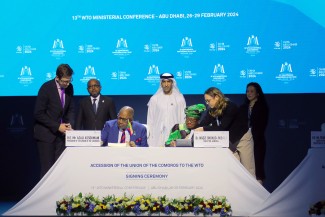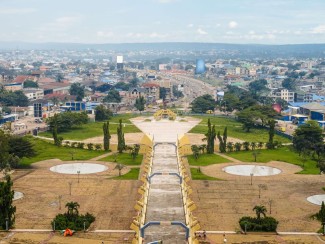Facilitating trade across borders means transparency, assistance and knowing what countries need
53 days. That is the length of time it used to take to import goods into Zambia through the 18 agencies that operate at the border.
“Every agency has to inspect every item passing across the border. This is why it would take so long to clear goods,” says Lillian Bwalya, Director of Zambia’s Ministry of Commerce, Trade and Industry.
Recognising that this was discouraging some businesses from trading across borders as well as limiting investment, Zambia has introduced a series of reforms to cut import time to 48 hours.
But these reforms may not have happened without both a landmark global trade agreement and the support of a global trade facilitation facility.
After nearly two decades of discussions and negotiation, in 2017 the Trade Facilitation Agreement (TFA) entered into force, ratified by 2/3rds of World Trade Organization (WTO) members and the organization’s first multilateral deal.
Hailed as one of the biggest trade reforms in a generation, the TFA commits countries to 38 provisions to simplify, modernize and harmonise their export and import processes. Some of these provisions include:
-- making border requirements available online and enabling electronic form submission (rather than paper form submission)
-- implementing risk management processes and trusted trader programs to prioritise inspection of goods deemed to be high risk (rather than the time-consuming process of inspecting all goods)
-- ensuring border agencies are able to collaborate through programs like the Single Window.
“Because LDCs have the biggest barriers – they have the most red tape, many of them are landlocked and it costs more to transit through multiple countries making them less attractive to investment – so they have the most to gain by implementing the TFA.”
Sheri Rosenow, WTO Counsellor
“All of the provisions in the TFA are already being used somewhere in the world with success, which is why they were proposed for the Agreement. They are aimed at making processes more transparent, efficient and to streamline traders that are trusted, which will enable countries to spend more time on the high-risk goods,” said Sheri Rosenow, counsellor at the WTO.
The TFA has been forecast to slash trade times by up to 91% over the current average, and reduce trade costs by an average of 14.3%. According to a 2015 study carried out by WTO economists, developing and Least Developed Countries (LDCs) have the most to gain, with LDCs likely to see an increase in export value of up to 35% once they implement the TFA. So far, 22 LDCs in Africa, Asia, and the Pacific have signed the TFA and are working towards implementation.
“Because LDCs have the biggest barriers – they have the most red tape, many of them are landlocked and it costs more to transit through multiple countries making them less attractive to investment – so they have the most to gain by implementing the TFA,” Rosenow said.
Unlike other multilateral agreements, the TFA allows developing countries and LDCs to set their own implementation deadlines by notifying each of the provisions in one of three categories.
‘Category A’ commitments are those that a country is already implementing, ‘Category B’ commitments are those that require more time for implementation, and ‘Category C’ commitments are those that require time and assistance to be implemented.
But even with generous timeframes, reforms come with costs. This was a major concern for many LDC governments, said Bwalya.
“The LDCs fought for a framework to help them do the reforms and comply with the agreement,” she said.
So the WTO set up a Trade Facilitation Agreement Facility (TFAF). The TFAF has assisted countries to categorise TFA provisions into Categories A, B and C by helping them to conduct needs assessments.
"What has made the most difference overall are the needs assessments, which started during the negotiations in 2007,” said Rosenow, who is head of the Facility.
“We worked with countries to identify what they would need to implement, what technical assistance they need and how much time they need. That made a big impact on the negotiations and gave them the basis for their notifications.”
The TFAF has also helped LDCs to leverage funds needed to implement reforms, and conducted regional workshops to help LDC government officials, parliamentarians and the private sector fully understand the agreement.
Bwalya says the TFAF has been instrumental in enabling participation of Zambian officials in TFA meetings.
“The TFAF has supported us to share our progress on trade facilitation at these meetings, as well as collaborate with the donor community to leverage funding from other partners.”
What Zambia needs now, she said, is more tailored training and support to enable their border force agencies to be less reliant on external entities. This follows from earlier recommendations emerging from EIF’s trade analysis of the country in 2014.
“We want to institutionalize the TFA reforms within the agencies themselves, rather than depending on external people to do it all the time,” Bwalya said.
With the second anniversary of the TFA in February 2019, Rosenow is keen to ensure the 12 LDC countries that haven’t yet ratified the Agreement, and those LDCs that have not met the notification requirements, are aware that the Facility can help them find the assistance they need.
“We’re getting the word out… This year we’re going to be contacting those countries to ask if there’s anything we can help with.”
“However, it is up to countries to decide who they want to work with. We will continue to make information available and create opportunities to talk to donors. Our door is always open.”
If you would like to reuse any material published here, please let us know by sending an email to EIF Communications: eifcommunications@wto.org.



